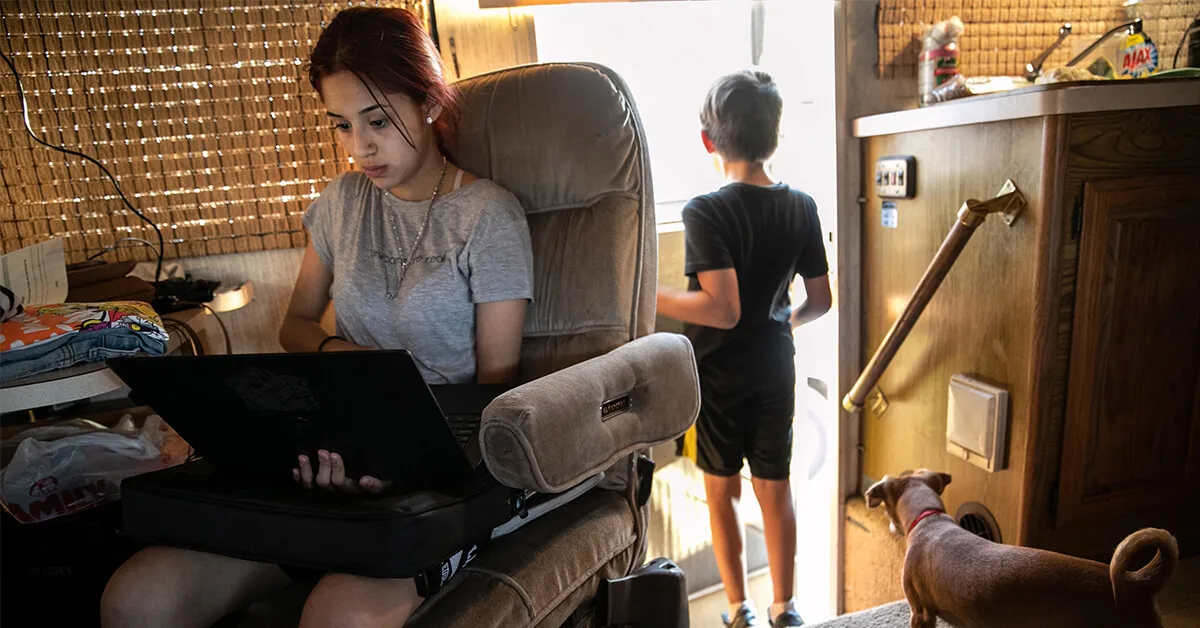
Photo by John Moore/Getty Images
As Mesa schools press reset and return to online learning next month, more districts could follow this week.
Mesa Public Schools, the state’s largest school district, announced last week that it would temporarily return to online classes in January as cases of COVID-19 continue to rise across the state.
More districts around the Valley could decide this week whether to follow their lead.
Mesa Public Schools, which serves approximately 59,000 students, said Thursday that its students would return to online learning from Jan. 4-15, when classes resume after winter break.
Several districts have already pivoted back to remote learning, but others continue to hold in-person classes. While some districts have handled closures on a school-by-school basis, others, like the Phoenix Union High School District and the Tucson Unified School District, have so far opted not to return to in-person classes this semester.
In a district letter sent Thursday, Mesa Superintendent Andi Fourlis acknowledged that county health metrics have shown an increased spread of the virus through the school community. There were 432.57 cases per 100,000 residents and a 13.85% positive test rate in the district as of Thursday, according to the letter.
Fourlis said the district would take the two weeks of remote learning to update its database of positive COVID-19 cases and use the data to determine whether the district should return to in-person classes on Jan. 19.
Fourlis also asked teachers and parents in the district to continue following health guidelines during the winter break, including wearing masks, social distancing, washing hands, and staying home when sick.
“We must continue to work together to prioritize the safety of our students and staff,” Fourlis wrote. “We need your help to remain Safe.Strong.Ready. in 2021.”
The announcement came after the Mesa Education Association, the district’s teacher’s union, penned a letter over the Thanksgiving weekend urging Fourlis to transition the district back to remote learning.
“Until this spread is truly under control and there is a widespread community awareness in working together, we cannot continue to put the lives of the students and educators in jeopardy,” the letter read.
Among the Mesa teachers polled by the union, 66% wanted to return to online learning after Thanksgiving, and another 10% said the district should return to online learning when at least two of the benchmarks were in red, which signals when there is a significant level of community spread of the virus, according to the letter.
Following the district’s decision to return to remote learning, MEA President Joshua Buckley acknowledged the “mixed feelings” among teachers and staff about the announcement but supported the district’s decision to use data and metrics in deciding to reopen.
“Our numbers are high, our cases are high, and we need this reset,” Buckley wrote in a statement. “I am glad to see that the voices of educators came into play and nudged us towards health and safety although maybe not as quickly or as soon as we wanted.”
Where Do the Largest Districts Stand?
Under county health metrics established to help schools understand the level of community spread of the virus in their area, schools monitor three criteria when determining whether to stay open: the number of cases, the percentage of positive tests, and the rate of hospital visits.
If all three of those criteria are in the red, or if there is a substantial level of community spread of the virus in a school community, the county recommends schools transition to online learning.
But the county’s health recommendations are just that — recommendations.
Before schools reopened for in-person instruction this summer, Gov. Doug Ducey left the decision up to school leaders.At least two districts, J.O. Combs Unified and Queen Creek Unified, reopened despite not meeting the health benchmarks. The Queen Creek district now has one of the highest case rates of any district in the Valley, with 565.48 cases per 100,000 residents.
As of Thursday, almost every district in Maricopa County had two health metrics in the red, but some districts have yet to halt in-person classes. Some of the largest districts that have remained open for in-person instruction include the Chandler Unified, Peoria Unified, and Deer Valley Unified districts.
Chandler Unified School District
The Chandler Unified School District, which serves approximately 44,000 students, had two health metrics in the red as of Thursday, with 499.78 cases per 100,000 residents and an 11.5% positivity rate.
Katie Nash, the president of the Chandler Education Association, told The Copper Courier that Chandler teachers have grown more concerned, and more teachers have supported pivoting to a remote learning environment, as cases have continued to climb.
The district has reached its tipping point, she said.
Nash, the head of the Chandler teacher’s union, said there were mixed feelings among teachers and administrators in her district, but emphasized that decisions should not be made without gauging the input of support staff, many of whom are hourly and could go without pay during school closures.
But Nash said elected officials at the state level should be making decisions about whether schools should close or stay open, not individual districts and educators.
The reopening decisions roiled districts and families, many of whom were split about the return to in-person classes. And the division has persisted.
On Friday, ABC15 reported that Paradise Valley Unified Superintendent Jesse Welsh, whose district recently returned to remote learning, and his family had been receiving threats and harassment at their home and at their children’s school. He has since resigned.
“It is pitting (districts) against each other. We’re all competing for the same set of kiddos,” Nash said. “It’s destroying public schools. It’s absolutely what Arizona has been all about.”
Peoria and Deer Valley Unified School Districts
In Peoria, two of the county’s health metrics were in the red, with 321.97 cases per 100,000 residents and a 11.5% positivity rate as of Thursday, according to county health metrics.
Peoria Unified Superintendent Jason Reynolds said in a video address to parents last week that health benchmarks continue to worsen and that the district was preparing for a move back to virtual learning.
District spokesperson Terry Locke said the district was weighing the direct impact of COVID-19 on its schools when considering returning to online learning. The district had a 1% rate of active COVID-19 cases for high schools, 1.5% for junior high schools and 2% for elementary schools as of Monday, according to Locke.
In Deer Valley, only one metric was in the red as of Thursday: the number of cases, with 285.46 cases per 100,000 residents.
“We want to make sure that we are ready in the event we need to move to virtual learning to start the second semester,” Reynolds said. “If we move to red in all three categories, we need to act to keep our students and adults that enter our schools each and every day safe.”
“There’s no good answer. Somebody is always going to be upset,” Nash, in Chandler, said. “You just have to balance everything in terms of what’s best for kids and that’s best for teachers.”
COVID-19 Whiplash
But returning to virtual learning posits its own challenges.
Nash says teachers were working overtime at the beginning of the school year to create virtual lesson plans, with some teachers clocking 10-14 hour days, sometimes six to seven days a week.
“There was no work-life balance,” Nash said. “You’re getting emails, text messages, whatever, from kids and families 24/7.”
However, with more students being forced to quarantine after testing positive for the virus or coming into contact with those who have tested positive, teachers are having to balance teaching their students in-person while simultaneously providing online instruction to those at home.
Chandler has reported a total of 517 cases of COVID-19 since the start of the school year, according to their district dashboard, while only 10% are active cases.
But, without a stay-at-home order from the governor, Nash says a return to virtual learning means students will have more time to see their friends and eat out at restaurants with their families, which could lead to further spread of the virus.
Putting Schools at Risk
More reports have been coming in of parents hosting parties and even winter formals at their homes, she said.
“Those folks need to be fined,” Nash said. “You cannot be doing that in a pandemic and expect a school to stay open when you are knowingly putting your schools at risk.”
Nash said the district could take a cue from Mesa and close for the first two weeks of the semester to see if the closure helps bring down case numbers, but that without statewide mask mandates and stay-at-home orders, she’s not optimistic that case numbers will go down over winter break.
“Does it help bring the numbers down? If not, maybe it wasn’t worth it,” she says. “If it does, then maybe we can continue to stay that course. We just need data to back it up.”
The Deer Valley Unified Governing Board will meet Tuesday but is not scheduled to take action on any moves from in-person to online learning.
The Chandler Unified Governing Board will discuss in-person and virtual instructional options at their board meeting on Wednesday, while the Peoria Unified Governing Board is scheduled to discuss learning models for next semester on Thursday.
Politics

State Official: 1864 abortion ban gives Arizona ‘black eye’
Arizona’s role at the forefront of the climate crisis, defending democratic elections, and protecting reproductive rights has caught the attention...

Biden makes 4 million more workers eligible for overtime pay
The Biden administration announced a new rule Tuesday to expand overtime pay for around 4 million lower-paid salaried employees nationwide. The...
Local News

Arizona’s reality TV stars: Where are they now?
From A-list actresses to a controversial bachelor, here's a roundup of reality TV stars from Arizona. Whether you love it or hate it, reality TV is...

New funding keeps the homeownership dream alive for Avondale families
In a unanimous decision, the Maricopa County Board of Supervisors approved an additional $796,326 on March 27 to boost homeownership opportunities...




